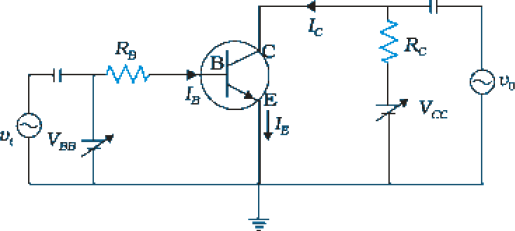For a common emitter circuit if then the current gain for the common emitter circuit will be:
1. 49
2. 98
3. 4.9
4. 25.5
1. 49
2. 98
3. 4.9
4. 25.5
An n-p-n transistor conducts when:
| 1. | both collector and emitter are positive with respect to the base |
| 2. | collector is positive and the emitter is negative with respect to the base |
| 3. | collector is positive and the emitter is at the same potential as the base |
| 4. | both collector and emitter are negative with respect to the base |
The output characteristics of a transistor are shown in the figure. When is \(10\) V and = \(4.0\) mA, the value of is:

1. \(200\)
2. \(250\)
3. \(150\)
4. \(100\)
The output characteristics of a transistor are shown in the figure. When is 10 V and = 4.0 mA, the value of is:

1. 200
2. 250
3. 300
4. 150
For a Silicon CE transistor amplifier, the audio signal voltage across the collector resistance of 2.0 k is 2.0 V. Suppose the current amplification factor of the transistor is 100, what should be the value of in series with the supply of 2.0 V if the dc base current has to be 10 times the signal current?

For a Silicon CE transistor amplifier, the audio signal voltage across the collector resistance of 2.0 k is 2.0 V. Suppose the current amplification factor of the transistor is 100 if the dc base current has to be 10 times the signal current. The dc current across through the collector resistance will be:

1. 0.1 mA
2. 10 mA
3. 1.0 mA
4. 0.01 mA
In figure, the supply can be varied from 0 V to 5.0 V. The Si transistor has = 250 and = 100 k, = 1 K, = 5.0 V. Assume that when the transistor is saturated, = 0 V and = 0.8V. The minimum base current, for which the transistor will reach saturation is:

In figure, the supply can be varied from 0 V to 5.0 V. The Si transistor has = 250 and = 100 k, = 1 K, = 5.0 V. Assume that when the transistor is saturated, = 0 V and = 0.8V. The input voltage for which the transistor will reach saturation is:

1. 0.8 V
2. 5.0 V
3. 2.8 V
4. 1.4 V
For a transistor , the current gain for a common emitter configuration will be:
1. \(12\)
2. \(6\)
3. \(48\)
4. \(24\)
If a common emitter circuit is used as an amplifier, its current gain is \(50.\) If input resistance is \(1\) kΩ and input voltage is \(5\) V, then output current will be:
1. \(250\) mA
2. \(30\) mA
3. \(50\) mA
4. \(100\) mA




